Just like a dictionary is a language in retrospect, education is a window into… the past. It’s painfully lagging behind our needs, both in content and methods. Take e-learning apps – so plentiful on the market but scarce in class. Smartphones are stigmatized as distractors, cheat devices, addictive gadgets and banned from the classroom.
And that’s sad, given the potential educational apps have to offer us in schooling – time and inspiration to teachers; motivation and support to students; transparency to parents.

If the quote above holds true, educational technology is our fast lane to the ROI. Want a proof?
Take today’s average entrepreneurial age of 45. It’s not long before that is cut in two. The precedents are there. With the right tools to access knowledge, kids now become millionaires out of the classroom – just at 15! Spot on, Benjamin Franklin!So instead of talking ‘disruption of education’, let’s learn the intricacies of developing an awesome educational app. Use the plan below to skip to a question of your interest:
- How large is the educational app world
- Step 1. Design for quality and product excellence
- Seven dimensions of creating an educational app
- King’s ransom for educational content
- Four pillars of an e-learning app design
- Five things to avoid in educational apps
- Step 2. Know your development options
- How much for the education app development
- Mobile learning app feature list
- Next-gen technologies enter educational apps
- Step 3. Monetize an educational app
How large is the educational app world
According to Statista, the e-learning market worldwide is expected to surpass 243 billion U.S. dollars by 2022. The number of e-learning mobile apps approaches 600K to-date – 275,210 on App Store and 308,438 on Google Play.
To give you a clue to its diversity, here’s the product categorisation by EdSurge. Educational software falls into five categories.
- Curriculum products: provide aid with teaching concepts and skills. Curriculum products ask for standards compliance, especially with the evolution of Common Core standards.
- Teacher needs: help teachers with classroom-related activities like grading, classroom management, lesson planning, etc.
- School operations: primarily designed for use by principals and school administrators to manage schools and educational process participants.
- Post-secondary: aim at learners, admins, professors, and parents involved in post-secondary learning environment.
- Everything else: complementary K-12 curriculum products or anything else loosely related to education.
With mobile learning underway, it’s a matter of a few years before most of these tools go mobile.
Curriculum products623 products that teach concepts |
Teacher needs748 apps to keep on-track |
School operations438 apps to keep school humming |
Post-secondary321 collaborative products |
Everything else562 products for everything else |
|---|---|---|---|---|
| 21st century skills (62) | Assessment (101) | Communications Tools (83) | Adult Basic Education (20) | App Discovery (10) |
| Arts (14) | Classroom Efficiency (34) | Data Systems (65) | College Prep (38) | Apps for Children (40) |
| Engineering (68) | Classroom Management (53) | Education Service Providers (23) | Community College (4) | Apps for Parents (7) |
| Language Arts (177) | Classroom Response System (31) | Finances & Fees (17) | Collaboration Tools (12) | Authoring Tools (32) |
| Language Learning (69) | Collaboration Tools (55) | Fundraising (13) | Digital Courseware (22) | Resource Discovery & Curation (36) |
| Math (210) | Curriculum Platforms (47) | Help Desk (9) | ePortfolios (14) | Content Marketplace (20) |
| Science (98) | Grading & Attendance (17) | Learning Management Systems (61) | Career Planning (22) | Professional Skills (45) |
| Social Studies (40) | Lesson Planning (49) | Networks & Hardware (12) | Job Search (17) | Digital Textbooks (14) |
| Professional Learning (55) | Professional Development (68) | MOOCs & Courses (54) | Digital Storytelling (18) | |
| Presentation Tools (33) | Student Information Systems (47) | Online Proctoring (6) | Games (67) | |
| Special Education (33) | Human Resources (13) | Student Coaching (9) | Hardware for Education (36) | |
| Other (26) | Paying for College (9) | Maker & DIY Tools (20) | ||
| Persistence & Retention (12) | Sites & Resources (49) | |||
| Test Prep (45) | Social Learning (16) | |||
| Textbook & Content Services (14) | Student Study Tools (59) | |||
| Other (32) | Tutoring (36) | |||
| Video Instruction (24) |
Source Edsurge.com
You’d be surprised to see the diversity in architecture and content of the many e-learning mobile apps:
- Multipurpose learning platforms
- Specific subject learning apps
- Supportive apps
- Educational games
- Learning management apps
- Educational apps for preschoolers and toddlers
Objective-wise, the apps range from instructive (drill-and-practice) through manipulable (discovery-and-experimentation) to constructive ones (open-ended ‘sandboxes’), in accord with Bloom’s hierarchy of learning. Some of those aim at knowledge and skills acquisition, others at collaboration, yet others – at learning and teaching support, and the list goes on. The consumer market covers various needs – from kid to adult solutions, special needs apps, corporate training tools and whatnot.
But the number and diversity of learning applications do not necessarily guarantee quality. In fact, the first generation of mobile learning apps has shown there’s a vast area of improvement. So let these insights guide you through the education app development process.
Step 1. Design for quality and product excellence
Let’s talk about designing an educational app. Applying an engineering-style and problem-solution thinking to complex domains like education is a real challenge. Knowing how to align the app’s design and use with the processes of learning and development asks for the proper understanding of the learning science.
Seven dimensions of creating an educational app
In an e-learning app architecture, these seven dimensions shape the Product Roadmap:
- Temporal: synchronous / asynchronous user interaction
- Communication: uni- / bidirectional information flow
- Transaction: capability of in-app purchases
- Public: open to public / limited to a particular group
- Multiplicity: the app alone / a community of other participants
- Location: information or functionality customized for user location
- Identity: information adjustment based on user identity
King’s ransom for educational content
Content is king, right? Well, then be prepared to pay a king’s ransom for the educational content. There’s no bypass. It has to comply, engage, drive results. Remember it’s what users come for. You won’t succeed by feeding mediocre user-generated content (think YouTube) or marketing-driven pieces (think Google). Your consumers are a most discerning and result-oriented sort.
Teachers have always been dedicated creators of syllabus, producers and performers of lesson plans, best marketers to pilot their projects with early adopters (aka students). Today’s educators are more that #JustaTeacher, familiar with ins and out of the process, and tech savvy as never before. In fact, curriculum writers are among the hottest jobs on the EdTech market. So make sure you have a bunch of domain experts among those who make an educational app.
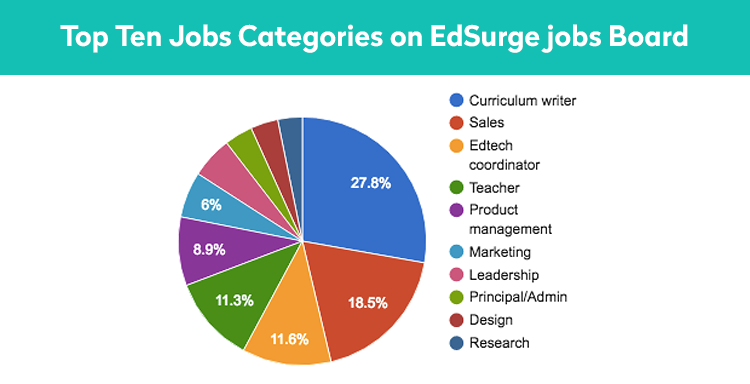
Four pillars of an e-learning app design
But content isn’t just enough. Designing an appropriate learning flow is equally important. Have you ever wondered what makes an educational app truly ‘learning’ by design? Humans learn best when they are…
- actively involved (‘minds-on’)
- engaged with the learning materials
- have meaningful experiences
- socially interact with others in high-quality ways
At the end of the day, those who develop educational apps to promote active, engaging, meaningful, and socially interactive learning are the winners. And you can too!
Active involvement
In an education mobile app development, active learning takes a variety of forms – kinetic (touching, moving, swiping), voice interaction (repeating, singing), cognitive (interpreting and manipulating symbolic systems), etc.
How to direct this activity towards a learning goal? When kids deal with symbolic systems like language, numbers, musical scale, geographic maps, it’s important to reinforce those with physical objects or phenomena representations, e.g. melody, pictures, etc.
Active also means distraction-free, staying in control and giving full attention to the learning process. Thus even a kid’s controlling a mouse while reading an interactive book with a parent is conducive to active involvement.
Engagement
How to create an educational app that engages? Engagement happens on different levels – behavioral, emotional, cognitive. The app’s design should balance the core educational content with motivational elements. It means the right blend of these:
- Responsiveness. Contingent interaction happens when each action meets a response. A user then feels in control and keeps interacting, thus responsiveness is the core of the UI design.
- Extrinsic motivation and feedback (e.g. ‘correct/incorrect’ labels, motivational messages ‘Great job!’/‘Try again!’, sound effects and animation, points and badges, access to additional content) help a learner estimate their progress. But make sure you praise the effort, not intelligence, to foster a growth mindset (C.Dweck).
- Intrinsic motivation. Kids are intrinsically motivated to discover, solve problems, create. Thus stickers and badges are even less effective than ‘hints’ towards the discovery. Open-ended ‘sandbox’ apps evoke a player’s unique abilities and create a deeply engaging state of ‘flow’.
Since motivational elements can be distracting, create an interface that allows to switch off the bells and whistles.
Meaningful learning
As opposed to cramming or rote learning, where knowledge doesn’t stick for long, meaningful learning has a purpose, personal relevance, and builds links to the preexisting knowledge base. For retention to happen, learning should follow certain principles:
- Gradation: generic-to-specific, simple-to-complex
- Systematization: in connection rather than isolation
- Repetition: emphasis on drilling, revising, and recycling to form skills
- Contextualization: embedding abstract concepts in a real-life context
That will mean educational apps should be used selectively to reinforce certain subjects and areas of learning. For example, learning vocabulary is cited as particularly tough with middle-school children. So that’s where the use of apps will shine. Or take kids and math. Why not prompt young kids to find a triangle in their home via an AR app and praise the right answer with a witty animation? Abstractions and symbols become clear via visual metaphors.
Social interaction
One domain that particularly benefits from social learning is language. We learn a lot by imitation. Infants tend to catch up with elder siblings easily, school kids benefit from collaborative learning compared to solo efforts. One area that specifically needs collaboration is critical thinking. Getting ideas across and thinking through an argument creates a synergy of deeper understanding.
Check out our e-learning portfolio: Corporate Online Learning Mobile Application for SkillPill
Five things to avoid while developing learning apps
Creating educational apps, especially those designed for kids, is a neat idea. But none of us wants our kid for a guinea pig. Revisiting the first wave of the apps gives us some insights into what qualities are red flags in educational app development:
- The fire-alarm syndrome. Focus is key. Distractions prevent information retention. Bells and whistles are like a fire alarm seizing the focus as soon as it goes off.
- The too-many-choices trap. Educational app developers know that too much choice is overwhelming. It impairs decision making.
- Masquerading ‘educational’ app. Numbers and letters alone don’t make an app truly educational. Together with that, the underlying principles and basic concepts need to be included. After all, what do we need abstractions for if not to better understand the real world?
- Empty calories. The right balance of user engagement and educational content will prevent the pitfall of low-value, purely entertaining apps where success is a result of pure luck rather than a skill acquisition.
- The attention-deficit design. Less is more. A constant switch between activities (math, arts, literacy) wreaks havoc. It hinders the depth of processing required for solid learning. Repetition makes excellence. Spotting the same item in multiple contexts reinforces learning, especially with younger children.
To recap the intricacies of an educational app design, check the infographic below.
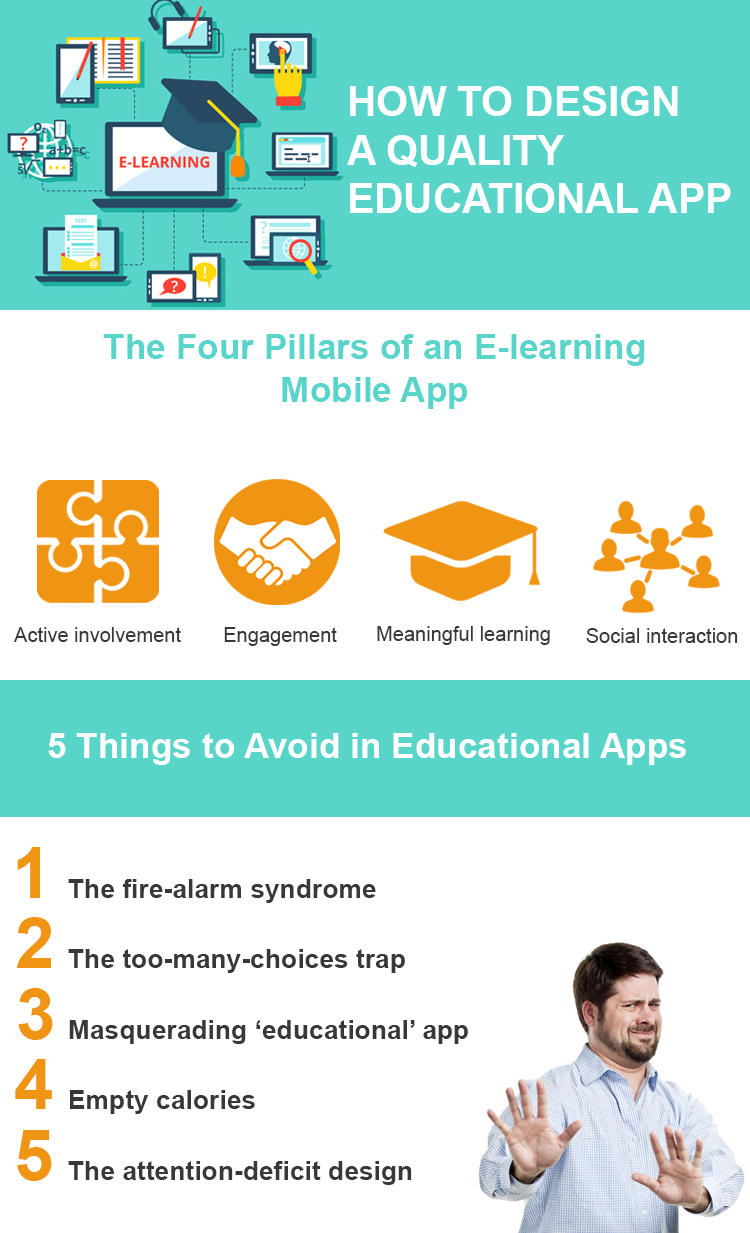
Step 2. Know your development options
How much to build an educational app
Knowing a ballpark for the time and cost to develop an educational app makes it easier to plan the budget before going into the education application development. But two similar projects can drastically vary in cost. You just cannot assign features a set price and expect the price to be the same across every project. A research suggests that to develop just one screen of a mobile application takes about one week with a full time employee (FTE). That includes planning, development, and then testing and final approval. So an eight-page mobile app will take about two months. Multiply this by the hourly salary of your FTE to get a ballpark of costs. And that’s excluding other overheads like developer licenses for app creation tools.
Mobile learning app feature list
When you create an educational app, this functionality is always desirable.

Next-gen technologies in educational app development
Emerging technologies and approaches are waiting to be implemented within mobile learning apps.
AR engages all senses
Augmented reality enhances real-world experiences. Be it an art museum or a park, AR technologies can take any situation, location, environment, or experience to a new quality level. AR is uniquely changing the way people learn with mobile devices.
Ideas for AR apps are everywhere – just look around. Explore the night sky with a Star Chart, go to the forest with a Leafsnap, or learn languages on the go with Google Translate and Word Lens. There are tools for teachers and students on EON Creator AVR to devise their own AR & VR content. Students visualize any topic on subjects ranging from history to science. Teachers create a training curriculum and monitor, assess and correct students’ progress through the app.
VR enhances experiential learning
Virtual reality creates total immersion into the learning process. Want to hone your rhetoric skills? Public Speaking VR is at your disposal. Young kids will just love Quiver, a 3D coloring app. Watch an image you just colored turn live and spring off the page. What a final to a creative arts class! Picture animation with sound overlay is something not to miss! While older students would appreciate taking a VR tour to the world’s best museums via Boulevard. Unimersiv and Sites in VR are irreplaceable for history classes, just like anatomy learning will get more involving with InMind.
But using what others had developed is not so exciting as moving into a creation mode with apps like CoSpacesEdu or learning coding with Blockly, a visual tool that introduces the logic of coding, JavaScript or TypeScript. Whether it is a chemistry lab, sports simulations, or 3D design class, VR apps have it covered. The AR/VR market’s worth is expected to reach $120 billion by 2020.
AI boosts learning capability
AI makes adaptive learning a reality. Via formative assessment, smart algorithms adjust the style, pace, and content to a learner’s abilities. No more averages, everyone gets their best.
Smart content creation gains ground. Netex Learning allows educators to design digital curriculum and content across devices, integrating rich media like video and audio, as well as self- or online-instructor assessment. As human interaction is a cornerstone of education, intelligent virtual assistants have been slow to enter the space. But there’s work for them, too. Language learning enhancement, instructing and management are just a few of the areas for IVAs. Intelligent tutoring systems are making their way to education via Parla, a Spanish-learning app, or DuoLingo’s AI-powered characters. A language learning AI-powered platform Glossika claims it can teach a foreign language from beginner to fluency in just a few months – through once-daily 20 minute lessons. The company’s CEO Michael Campbell says Glossika’s proprietary machine learning algorithms mean there’s ‘no need for language experts to figure out what to teach in what order – our AI figures out the complexity and sorting of any language automatically.’
Hopefully, a balance of both ‘intelligences’ will yield the best results. Captivating Virtual Instruction for Training (CVIT), for example, is a distributed learning strategy that aims to integrate live classroom methods with best-fit virtual technologies—including virtual facilitators, augmented reality, intelligent tutor, and others—in remote learning and training programs.
Gamification adds excitement to a non-game context
Motivation, so vital in education and often challenging in traditional classrooms, comes natural in games, where getting some arbitrary rank or reaching the next level have little to none practical value. Luckily, the basic elements of gaming and learning overlap – in particular, setting objectives, building a strategy, and getting rewards are common steps. And not just in kids’ apps. Gamification has been big in employee performance, customer engagement, and crowdsourcing initiatives.
An example is a location-based mobile app for orientation at Dartmouth College and Webster University. The app sends freshmen on a scavenger hunt using a smartphone. With customizable treks and challenges, it is informative and interactive, a great alternative to boring paper handouts.
Multiplicity creates a positive loop
Build an educational app driven by a learners’ community. It’s a win-win strategy. Businesses get traction. Learners get social experience, assistance, and support. It’s especially important for academic distance education, where churn is high due to the course complexity. An online community of like-minded individuals allows to shift between learning modes (T-S, peer-to-peer, pairwork, group work), which is essential for student engagement.
Community is indispensable in project-based learning (PBL). Engaging in meaningful practical tasks, solving burning problems across the globe is what makes education worthwhile.
Streaming grows mainstream in the corporate learning
Today’s corporate training has shifted towards learning ‘in the flow of work’. Josh Bersin says, the connection between corporate learning and video/audio streaming services is a taste of things to come. Modern learning molds well into a series of playlists and channels that you subscribe to and get personalized AI-powered recommendations, very much like on Netflix or Spotify. Businesses grasp the value of micro-learning and turn in the direction of providing their own video-learning platforms.
Want to create a video-learning platform? Check this: How to Create a Video Streaming Website like Netflix, Amazon, or Hulu
Step 3. Monetize an educational app
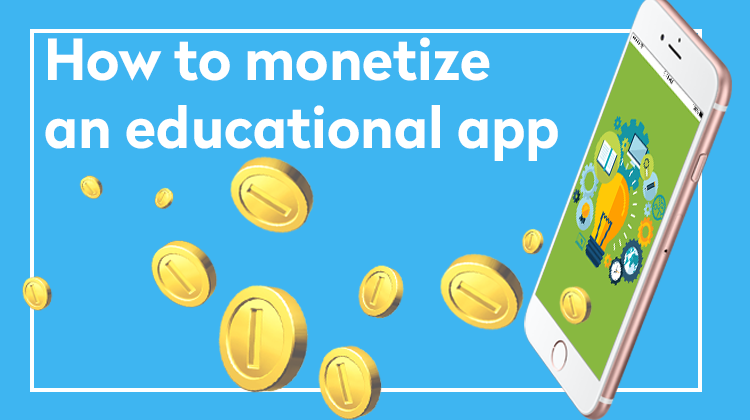
When you create an educational app, monetization takes time. For starters, Free model is ideal for attracting users. Because of the abundance of the apps of this sort, that’s about the only option. At least, give users a free trial to get to know your app. But building dependable revenue streams is part of an app’s success. So weigh your options.
- Subscription. A monthly subscription is the most popular method of monetizing an e-learning app. Alternatively, introduce various user plans for access to different functionality (free/paid/VIP/pro).
- Freemium. Paid features is where most free educational apps scale to. You cannot get VC injections forever. So think of some compelling features outside (!) your MVP that users will want to pay for.
- In-app purchases (IAP). Offering paid consumables within an app can be a red flag, especially with kids apps, as many parents struggle to protect their wallets. App Store gives parents guidance and tools against the strategy. So gracefully leaving users a choice to opt-out will give you more credit than being restrictive and manipulative.
- Commissions. If you provide a platform for user-generated content, you can charge an interest for a course viewing or a commission for posting a paid course.
- Paid download. Charge once for the app’s download. Paid model is only viable if you aim at the mass market. Remember to provide a free trial – no one enjoys a pig in the poke.
- Advertisement revenue. In-app ads are annoying so use them in moderation. Make sure you know the ad policy for your target market, especially if you build for kids. Advertising towards children is rightly limited by strict rules and regulations such as the Children’s Online Privacy Protection Act (COPPA) and the advertising industries own self regulation through the Children’s Advertising Review Unit (CARU).
- White-label your code. Can your app’s code be repurposed? Great! Why not make that an additional revenue stream?
Learn more about your monetization options in this post: How to Choose the Best Pricing Model for Your Mobile App – Tactics and Strategy.
Two business models of the top e-learning apps
A MOOC
Coursera has the biggest market share among MOOCs and received $210.1M of investment. It’s UVP – to give free access to world-class university courses – has quickly gained the company a competitive edge. Now Coursera’s monetization model has evolved from free to freemium. It has several revenue streams:
Monthly subscription. It drives most revenue for e-learning apps. A 7-day free trial leads to subscribing for a course at ~$39-79 per month. You’re also incentivized to accomplish a course faster if you want to cut costs.
Note! There’s still a free access if you opt for ‘audit the course’ instead of ‘free trial’.
- One-time purchases. Three ‘paid’ feature include specializations, professional certificate, and degrees.
- Specializations. These are ‘course bundles’ of 4-9 related courses on a one-time payment or subscription. The Capstone Project at the end of a specialization allows for real problem solving with a partnering company (fat chance of landing a job!).
- Professional certificate (new!). The certificate is comparable with those awarded on campus. The payment is higher ($15-25K for a course bundle).
- Degrees. Partnering with the University of Illinois and HEC Paris resulted in 4 Master Degree offers (admission required).
- Premium services (Signature track). Signature Track ‘securely links coursework to real identity’ via a verified certificate. This option (at ~$30-100) proved to be very popular, with the current monthly revenue of $1M.
- Course sponsorship. There’s an incentive for course producers, too. Brands can sponsor the production of a course created by a top university. They, in turn, benefit from the access to top talent. Though little is said about the effort, it seems fairly lucrative.
- Affiliates program. Coursera gets revenue from an Amazon.com affiliates program if users buy books suggested by professors.
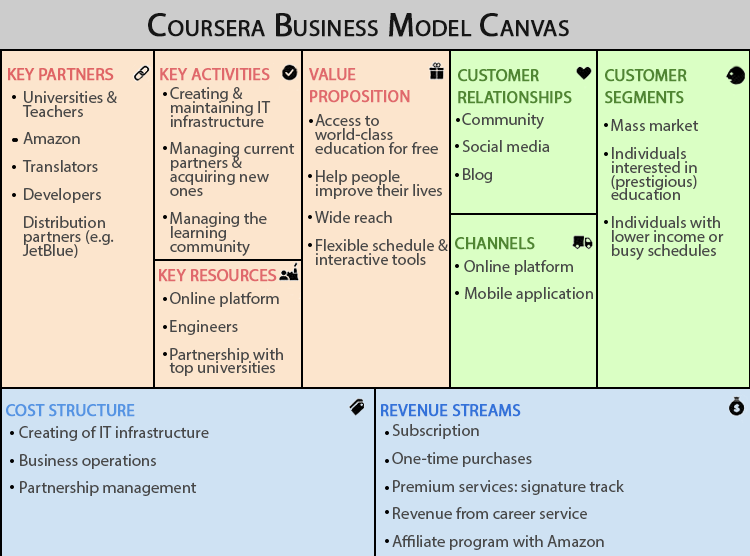
A language learning app
DuoLingo has over 200 million users worldwide. The market leader provides great UX by A/B testing and tracking everything. It also has irresistible UVP:
- Free high-quality language education
- Round-the-clock, round-the-globe, anything-with-internet access
- Easy-to-use, gamified approach
- Translation services for sponsors
By contrast with Coursera, the company has not gone back on its promise to deliver basic content free of charge. DuoLingo’s monetization strategy includes:
- Ads and in-app purchases. Users can pay to increase the number of lessons per day (1 lesson per day for free), to save streaks, or to take a test.
- Certificate Exam. A new paid service that came out of the partnership with Uber allows Uber drivers to take a Duolingo Certificate Exam if they want to qualify for UberEnglish – a service that allows for an English-speaking driver request. And that is a good start for language certification partnerships.
- Document translation crowdsourcing. There’s an innovative tactic DuoLingo utilises. The company crowdsources pieces of translation done by its students and sells them to companies like CNN and BuzzFeed. The learners do it for free as part of learning experience the clients get it way cheaper than with regular translators. Ain’t it neat! MIT thinks so.
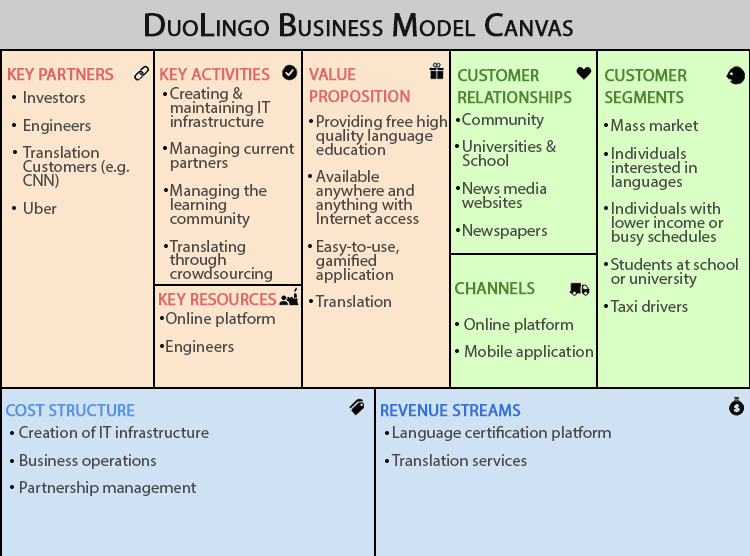
To conclude
There has never been a one-size-fits-all approach to education and learning. Nor is there a universal technology pill to make us smart overnight. Learning is a lifelong path we take only to discover our ignorance at the end of the journey. Let’s build the tools to make the journey enjoyable! Share your idea of developing an educational app in the comments.
How much does it cost to build an educational app with CodeTiburon?
Useful resources:
M.P.Notari et al. Mobile Learning Design: Theories and Application


Good One, I really appreciate your article.
Thanks & keep it up.
Thanks for taking the time to read it, Lokesh!
The educational apps market is white-hot right now. The truth is the edtech industry had been growing steadily even before the pandemic, but after COVID-19 made online education a must, edtech investments really spiked. Education app development results in the teaching process being more convenient and practical. But the article is very good, I appreciate that how you have explained everything in this Article.
Thank you for your comment! Much appreciated.
Good to read. Thanks for sharing